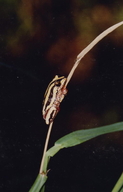|
Hyperolius marmoratus Rapp, 1842
Painted Reed Frog, Umgqagqa opendiwea (Zulu) | family: Hyperoliidae genus: Hyperolius |
| Species Description: Rapp, W. von. (1842). Neue Batrachier. Archiv für Naturgeschichte. Berlin 8: 289–291. | |
 © 2005 Wolfgang Ochojski (1 of 21) |
|
|
|
Description A medium-sized Hyperolius with a maximum body length of about 33 mm. Pupil horizontal. The adult color pattern is extremely variable and has led to many systematic and nomenclatural uncertainties about this ‘superspecies’. Ongoing investigations into the ecology, call structure and genetics of populations from different parts of Africa will help to resolve the taxonomy of this group (Minter et al. 2004). The pattern varies from distinct stripes through to vermiculations, dots and splotches, and the colours of the patterns vary from dark brown or black through to yellow and peppermint green. Juvenile males appear to be overall brown during their first breeding season (see photograph of juveniles in combat). For another description of H. marmoratus, see the H. viridiflavus superspecies account (by A. Schiøtz). Distribution and Habitat Country distribution from AmphibiaWeb's database: Gabon, Kenya, Mozambique, South Africa, Swaziland, Tanzania, United Republic of, Zimbabwe
Life History, Abundance, Activity, and Special Behaviors Although males will call after rain at any time of the year, breeding normally takes place from October to February. At low altitudes male calling behaviour is inhibited by temperatures below 16°C, while at higher altitudes breeding has been observed at temperatures below 10°C. During the day, adults usually move into the canopy of surrounding trees or bask in the sun on emergent vegetation at the edge of the breeding site. H. marmoratus utilise a wide variety of breeding sites, ranging from temporary ponds and seepages to permanent bodies of water such as dams, marshes, reedbeds, sluggish rivers and streams (Channing 2001). At dusk they descend to the pond where males take up specific call sites (which they return to on consecutive nights) and call consistently from dusk to just after midnight. Where present, tall emergent plants such as reeds and sedges (e.g. Eleocharis limosa, Cyperus papyrus and Typha latifolia) are favored as call sites, but males will also call from trees, grasses, bushes, floating vegetation or even bare soil at the water’s edge. On average, males only call for a few nights in a row, returning to the breeding chorus after a period of about 10 days (Dyson et al. 1992). Gravid females enter the pond shortly after dusk and usually select a mate within a few hours. After several hours in axillary amplexus, the eggs are laid in water. Females have been observed to lay more than one clutch of eggs per season with a month long interval between layings (pers. obs.). Between 150 and 650 eggs are laid in flattened clumps of about 20, on the surface of submerged leaves, stalks or stones or amongst the roots of aquatic plants (Channing 2001). Tadpoles hatch within 5 days and metamorphosis takes about 6-8 weeks. Trends and Threats The Painted Reed Frog is locally abundant and sub-populations often consist of hundreds or occasionally thousands of individuals. They occur in many protected areas including National Parks and appear not to require any further conservation action. Possible reasons for amphibian decline General habitat alteration and loss Comments
References
Channing, A. (2001). Amphibians of Central and Southern Africa. Cornell University Press, Ithaca, NY. Dyson, M.L., Passmore, N.I., Bishop, P.J., and Henzi, S.P. (1992). ''Male behaviour and correlates of male mating success in a population of African Painted Reed Frogs (Hyperolius marmoratus).'' Herpetologica, 48, 236-246. Minter, L.R., Burger, M., Harrison, J.A., Braack, H.H., Bishop, P.J., and Kloepfer, D. (eds.) (2004). Atlas and Red Data Book of the Frogs of South Africa, Lesotho and Swaziland. Volume 9 SI/MAB Series. Smithsonian, Washington D.C.. Phaka, F.M., Netherlands, E.C., Kruger, D.J.D., Du Preez, L.H. (2019). Folk taxonomy and indigenous names for frogs in Zululand, South Africa. J Ethnobiology Ethnomedicine 15, 17. [link] Schiøtz, A. (1999). Treefrogs of Africa. Edition Chimaira, Frankfurt am Main. Originally submitted by: Phil Bishop (first posted 2004-09-14) Edited by: Kellie Whittaker, Michelle S. Koo (2023-05-31) Species Account Citation: AmphibiaWeb 2023 Hyperolius marmoratus: Painted Reed Frog <https://amphibiaweb.org/species/550> University of California, Berkeley, CA, USA. Accessed Nov 21, 2024.
Feedback or comments about this page.
Citation: AmphibiaWeb. 2024. <https://amphibiaweb.org> University of California, Berkeley, CA, USA. Accessed 21 Nov 2024. AmphibiaWeb's policy on data use. |



 Map of Life
Map of Life